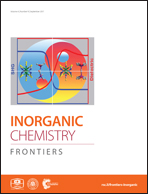[C5H12N]CdCl3: an ABX3 perovskite-type semiconducting switchable dielectric phase transition material†
Abstract
A new organic–inorganic ABX3 perovskite-type semiconducting hybrid, N-methylpyrrolidinium trichlorocadmate (MPCC), has been synthesized. It is found that MPCC exhibits semiconducting behaviour with an optical bandgap of ∼4.65 eV, as well as remarkable dielectric switching properties. It displays a structural phase transition (SPT) at Tc = 254 K, being confirmed by DSC and specific heat measurements. Dielectric measurements display distinct step-like anomalies around Tc, suggesting MPCC as a switchable dielectric material. Variable temperature single-crystal X-ray diffraction reveals that symmetry-breaking occurs from Pnma (at 280 K, >Tc) to P21/c (at 230 K, <Tc), which is attributed to the ordering of the disordered N-methylpyrrolidinium (MP) cation. The most distinct difference between its low- and high-temperature structures is the order–disorder dynamics of the MP cation, which mainly contribute to the SPT and switchable dielectric activities of MPCC. This finding paves a new way for designing multi-featured ABX3-type SPT hybrids by choosing disordered cationic moieties.
![Graphical abstract: [C5H12N]CdCl3: an ABX3 perovskite-type semiconducting switchable dielectric phase transition material](/en/Image/Get?imageInfo.ImageType=GA&imageInfo.ImageIdentifier.ManuscriptID=C7QI00301C&imageInfo.ImageIdentifier.Year=2017)


 Please wait while we load your content...
Please wait while we load your content...